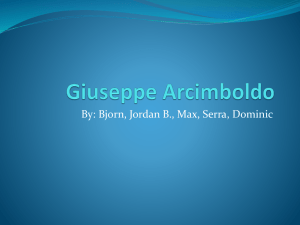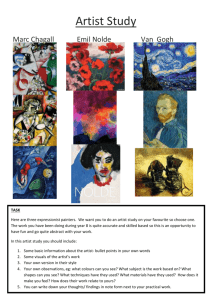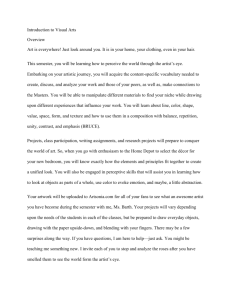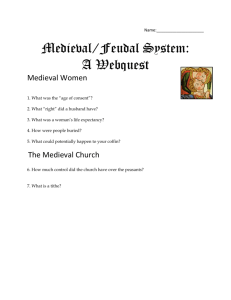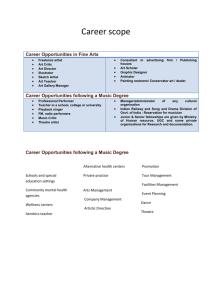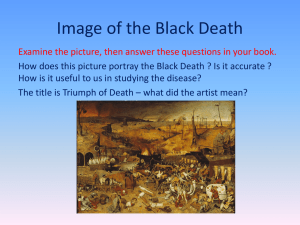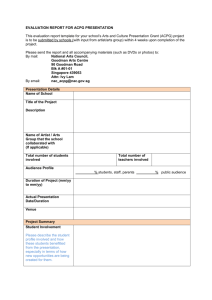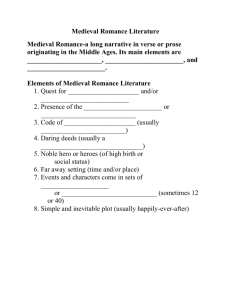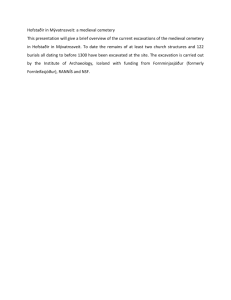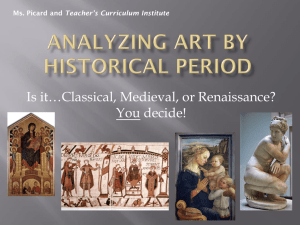Medieval Reconstruct..
advertisement
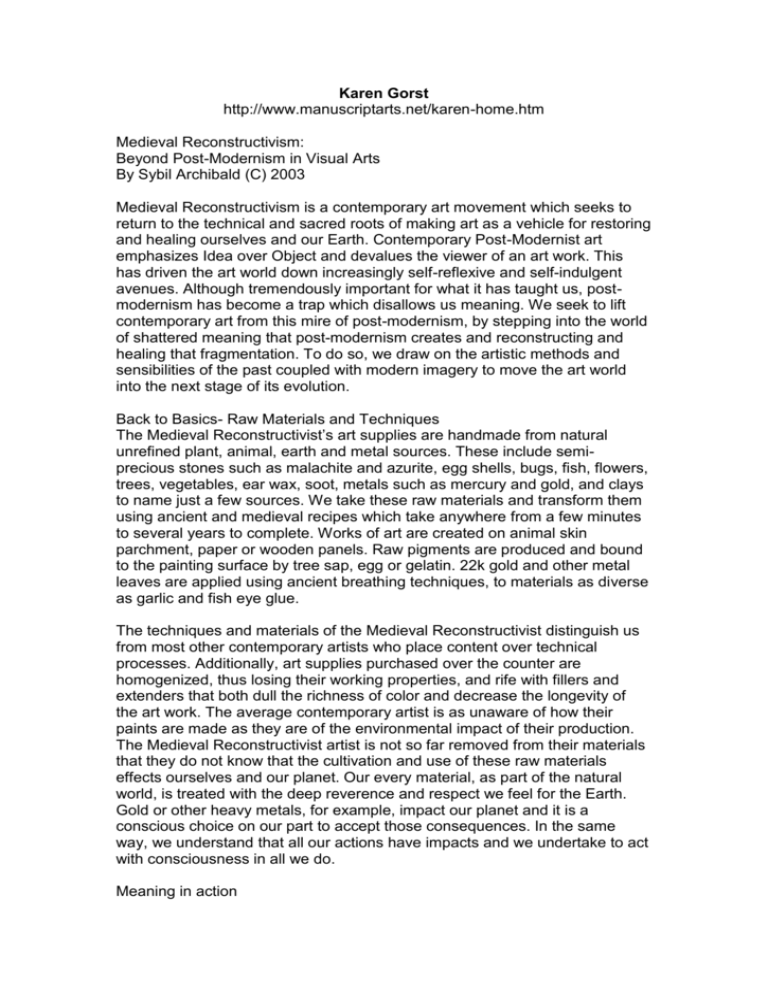
Karen Gorst http://www.manuscriptarts.net/karen-home.htm Medieval Reconstructivism: Beyond Post-Modernism in Visual Arts By Sybil Archibald (C) 2003 Medieval Reconstructivism is a contemporary art movement which seeks to return to the technical and sacred roots of making art as a vehicle for restoring and healing ourselves and our Earth. Contemporary Post-Modernist art emphasizes Idea over Object and devalues the viewer of an art work. This has driven the art world down increasingly self-reflexive and self-indulgent avenues. Although tremendously important for what it has taught us, postmodernism has become a trap which disallows us meaning. We seek to lift contemporary art from this mire of post-modernism, by stepping into the world of shattered meaning that post-modernism creates and reconstructing and healing that fragmentation. To do so, we draw on the artistic methods and sensibilities of the past coupled with modern imagery to move the art world into the next stage of its evolution. Back to Basics- Raw Materials and Techniques The Medieval Reconstructivist’s art supplies are handmade from natural unrefined plant, animal, earth and metal sources. These include semiprecious stones such as malachite and azurite, egg shells, bugs, fish, flowers, trees, vegetables, ear wax, soot, metals such as mercury and gold, and clays to name just a few sources. We take these raw materials and transform them using ancient and medieval recipes which take anywhere from a few minutes to several years to complete. Works of art are created on animal skin parchment, paper or wooden panels. Raw pigments are produced and bound to the painting surface by tree sap, egg or gelatin. 22k gold and other metal leaves are applied using ancient breathing techniques, to materials as diverse as garlic and fish eye glue. The techniques and materials of the Medieval Reconstructivist distinguish us from most other contemporary artists who place content over technical processes. Additionally, art supplies purchased over the counter are homogenized, thus losing their working properties, and rife with fillers and extenders that both dull the richness of color and decrease the longevity of the art work. The average contemporary artist is as unaware of how their paints are made as they are of the environmental impact of their production. The Medieval Reconstructivist artist is not so far removed from their materials that they do not know that the cultivation and use of these raw materials effects ourselves and our planet. Our every material, as part of the natural world, is treated with the deep reverence and respect we feel for the Earth. Gold or other heavy metals, for example, impact our planet and it is a conscious choice on our part to accept those consequences. In the same way, we understand that all our actions have impacts and we undertake to act with consciousness in all we do. Meaning in action In returning to ancient roots of art making, technique is one important aspect; the other, and equally as significant aspects, are the symbolic and spiritual meanings embedding in both the act of creating art materials and of creating artwork. A clear and beautiful example of symbolic meaning is the process of gilding. In technical terms, a bed of gesso including glue and red clay is applied to the painting’s surface and allowed to harden. Next a hot wet diaphragmatic breath is used to activate the glue and a thin layer of gold leaf is applied. Voila! A beautiful gilded paged. Simple sounding but technically difficult, and on a spiritual and symbolic level filled with a complex and rich meaning. In Hebrew, the word Adam, the first human, is linked to the word haadamah, meaning the ground or clay. Symbolically, the bed of gesso containing red clay represents Adam, and the breath used to activate the gesso represents God blowing the breath of life into the clay figure. Next, by applying the gold leaf, the painter transforms man’s rough and base nature as represented by the clay into his perfected spiritual state as represented by the gold. The symbolic level is fascinating, but it acts merely as a sign post directing us to the more important level, the spiritual. In the Middle Ages every technical process was so deeply linked to a spiritual process that they become indistinguishable. As the blank page was transformed into a more perfected state so, it was believed, was the artist’s soul. The spiritual meaning is not a fixed detail of knowledge. Rather it is something that occurs internally to the artist as they externally create a work of art. In the process of gilding, there are many stages, but the principles remain the same: surrender of the will and presence in the moment. The spiritual meaning comes from the artist’s confrontation with these states of being. To confront the spiritual, one must be properly prepared, hence, the first and most important stage of producing a work of art: the preparation of the surface to receive its image. The contemporary artist often finds that they have an idea which they wish to express and their energies are directed solely into constructing that message, often without so much as a sketch to go on; in the end, the ideas in the piece are valued over the object created. To the Medieval Reconstructivist, preparation is the necessary foundation to any work of art. This is so because our methods are technically complex, but also because it allows the artist to prepare themselves to receive the act of creation. Our materials shepherd us in this process at ever step through their own needs and constraints. For instance, while preparing a wooden panel with gesso, a mix of whiting with rabbit skin glue, if the artist is in to much of a hurry, the rabbit skin glue will crack.. We look back to Byzantine artists who saw the preparation of gessoed panels as preparing the bride for the wedding and the Medieval artists who regarded the preparation of parchment as a readying of the flesh to receive the soul. By respecting the nature of their materials and the preparation process, the artist slowly brings them self into alignment with their material and then through their materials into alignment with the pulse and flow of life, of Earth. The discursive thought of the mind is quieted and in this stillness we find the strength to move forward and more deeply into the process of creation. At every step from preparation through completion of an art work, our materials require our utmost attention. They are difficult to work with, finicky, influenced by weather and the smallest variations in the mixing of a recipe. When applying gesso, groves, bumps, and cracks are more often the result than smooth beds for golden sheets. From a technical perspective some problems can be explained, but without changing results, and some can not be explained. This can be a tremendous source of frustration, but the medieval artist teaches us to shift our approach: there is no problem with the materials, rather the problem is in the artist who pits their will against the will of what is, the will of nature. We want, even require our art materials to behave in certain ways. Today, art supplies, particularly paints are homogenized so that they all act in the same ways. Contemporary artists who have been deprived of the opportunities inherent in confronting their materials become disconnected with their own process. The ease of paint from a tube, for example, allows the artist to jump directly from concept to object, but also devalues an object so easily put forth in favor of the idea it is meant to portray. By returning to ancient techniques we not only restore longevity and luster to our works, but we restore the value of the art object as an integrated whole with the concepts behind it. Moreover, we restore the struggles with materials which is the echo of the struggles of our daily lives. To the Medieval Reconstructivist, the true nature of our materials is of utmost importance. Our materials simply exist in a certain state and by surrendering our wants and preconceived notions, often conditioned by contemporary homogenized materials, the artist allows their materials to guide them; in essence surrendering to divine will or the Universal mind. In gilding we say, in contemporary terms, that everyplace where gesso shows through, where the gold has not adhered, is thought to be a physical representation of our ego trying to control the process. The achievement of a soundly made bed of gold is only possible when the artist’s will and the divine will are one. This is the essence of the internal transformation which mirrors the external transformation of blank page to painting. Every block that an artist has to the natural flow of life, the cosmic rhythm is thrown in their way whilst trying to perfectly accomplish a technical act. To complete the act, whether it be gilding, painting or making ink, that blockage must be released. The artist by recognizing the block and turning to the nature of a material, surrendering to its guidance, releases that which blocked thus becoming transformed. As we are transformed the energy is captured in the art we make. In this way the material world, as represented in Medieval Reconstructivist paintings, can be caused to resonate with the universal mind. To allow materials to lead, the artist must be present to what they are doing. They must shut down and release the discursive thought that runs through the human mind at a dizzying pace. Without being present, the deep breath required to gild will not come, the gold will not stick, the gesso will crack, the paint will flake. So surrender coupled with presence, is a state of mind that may be described as perfect intent. By the act of creating art with perfect meditative intention, the artist emanates new forms, in the shape of works of art, which reach deep within to connect with the traces of the artist’s Source. The capacity to create is a by product or a direct result of our decision to release ourselves into a state free of our own small will, a state at one with the flow of life. We create unity out of a shattered self. Our internal movement to release language is fundamentally a generative state. In accepting divine reason we grow. This is not the divine reason of the Bible or Koran or any other religious text, it is the generative and secret truth of life. The creation of form calls that matter into being. How the History of Art Prepared the Ground for Medieval Reconstructivism The Medieval Reconstructivist artist represents the next step in artistic development beyond Post Modernist art. To see this evolution clearly, one needs to understand the deep divide in western art between the material and the spiritual worlds. We begin with the Middle Ages. The key to understanding the art of the Medieval period is knowing that the focus is on the spiritual world. There is a deep underlying mistrust of the physical world which plays out not only in the themes of physical mortification, i.e. saints lives, crucifixions, etc, but in the absence of perspective. Paintings in the linear fashion of the Middle Ages were designed to draw the mind away from the material world of three dimensions and into the spiritual non-material one. With the arrival of the Renaissance came belief in the value of the physical world. The desire to know and explore the world gave rise to more naturalistic representation, including perspective, in paintings, modern medicine, with experiments on cadavers, and modern sciences by focusing on the material world without the medieval judgment of the corrupt nature of material existence. As time moved forward in the Renaissance, the advent of humanism in many ways became a complete rejection of the Medieval perspective on life, emphasizing the desire to discover an objective external reality. From the Renaissance on, the art of portraying an ‘objective’ external reality is increasingly perfected through artist Michelangelo, Velasquez, Vermeer, Poussin, David and etc. until we reach the Impressionists. Impressionists also strove for this end but in a different way, they attempted to capture what the physical eye actually sees in an instant of vision. The impressionists introduced the idea that the naturalistic and realist paintings that preceded them were not actually as real as they seemed, that a painted tree did not actually resemble what the eye saw when viewing a real tree. This is the first indication of the concept of external ‘objective’ reality breaking down by questioning what that reality actually constitutes. Following on the heels of Impressionism, we begin to see a division in the direction of art movements as portrayed by Cezanne, leading to the Cubists and beyond, and Gauguin leading to the expressionists and symbolists and beyond. Cezanne and his heirs, began to breakdown objective reality, to show a mountain’s mountainess perhaps. His paintings no longer looked like the paintings of the proceeding naturalist movements; however, these paintings still focus on nature, on physical forms. Pitted against these modern movements was expressionist/symbolist art. In 1911 Kandinsky’s Concerning the Spiritual in Art, rails against the art establishment for its attachment to representing the real world, which he saw as materialistic. He calls for a rejection of this materialism and an embracing of the spiritual by rejecting natural form. Kandinsky and his heirs give us abstract art, unattached to form. But really symbolist and naturalist art represent two sides of one coin. Both these movements focus on form: naturalism on exploring the forms of the external world and symbolism on exploring the inner, so-called spiritual world, but its desire to break from external naturalist forms make its focus on form perhaps even greater. Through these movements, the concept of an objective external reality increasingly loses it viability. The culmination of these years of questioning objective external reality is of course, Post-Modernism. Post Modernism shows us that there is no objective standpoint. It fractures meaning and hierarchy creating an equality among all belief and structure. In art, Post Modernism has negated the importance of the viewer in favor of ‘art for art’s sake’. This stance, has led the art world into a self-reflexive morass where commentary on itself has become the overriding ethic, Contemporary art has become meaningless to all but an elite class of viewers and the actual piece of artwork, often, so poorly crafted that its longevity is severely threatened. Our Place in the Post-Modern world The Medieval Reconstructivist embraces the lessons of Post Modernism, we applaud the downfall of objective external reality and its "Truths" and history. But, although Post Modernism points to the end of history by showing how words spoken in real time can destroy a societies "Truths", it still leaves us in history because it leaves us in words and linguistic interpretations, upon interpretations ad infinitum. This emphasis on words and interpretations has helped to put the art world on its current path of self-reflexive commentary and helped to disconnect artists from the process of making art. Medieval Reconstructivism does not embrace history or language. We embrace process and action in present time. We whole-heartedly accept PostModernism’s teaching that there is no external objective standpoint, but we believe that this is only half of the answer. The very radical discontinuity that Post Modernism posits breaks us open to find an internal continuity. Shattering of meaning must ultimately come to its end in the release of the inner mind, the inner truth, that each of us hold separate and beneath the layers of external meanings that have been laid upon us. It allows us to join with the Universal Mind and the flow of life. Medieval Reconstructivism joins the questioning of the objective world begun in the Renaissance with the spirituality portrayed during the Middle Ages. In doing so, we have merged the perceived opposites of the physical and spiritual worlds. The physical is also the spiritual. We have traced our own origins back through physical form to the fundamental generative principal of life. But we are not interested in specific art forms as would be and expressionist or cubist. We differ dramatically from any proceeding art movement in that we do not care about the finished look of an art work, or even content, although we agree that these are tremendously powerful and important aspects. The hallmark of our art is process and technique. The diversity of visions among Medieval Reconstructivists is something we embrace and encourage. Through relationship to their materials and the struggles there in, through presence to the process of art-making, the Medieval Reconstructivist is transformed and those transformational energies become infused into the materials themselves. The artist’s internal transformation mirrors the metamorphosis of their materials: flowers to paint, glue to gold and dead skinparchment, to living image. Thus the artist causes the material world, their paintings, matter itself, to resonate with the Divine mind. This resonance can not help but effect the viewers of an art work and they become included in the healing process too. The artist’s own healing causes a ripple effect first to the viewer and then beyond. Each of us alive today is the land. Our physical bodies cannot be separated from the Earth, they are extensions and embodiments of it. When we damage the Earth, we damage ourselves. When we honor the Earth we honor ourselves. The Medieval Reconstructivist honors and reveres their materials for what they are: the Earth. Through relationship and process, we heal ourselves. By healing ourselves, we become more loving and more linked with the Divine mind, the fundamental generative principle, the flow of life. The whole of the material world is a mirror which reflects the light of the Divine. By transforming ourselves and our materials, we polish that mirror. Thus as we heal ourselves, we heal our world, our precious Earth. Sybil E. Archibald August 2002
